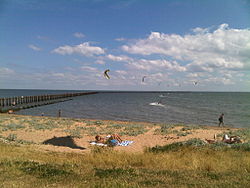Shoeburyness
| Shoeburyness | |
| Essex | |
|---|---|
 Shoebury East Beach | |
| Location | |
| Grid reference: | TQ941851 |
| Location: | 51°31’54"N, 0°47’52"E |
| Data | |
| Population: | 19,991 ((2001)) |
| Post town: | Southend-on-Sea |
| Postcode: | SS3 |
| Dialling code: | 01702 |
| Local Government | |
| Council: | Southend-on-Sea |
| Parliamentary constituency: |
Rochford and Southend East |
Shoeburyness (also called "Shoebury") is a town in south-eastern Essex, at the mouth of the Thames Estuary, around three miles east of Southend-on-Sea town centre. It is named from the bleak Shoebury Ness peninsula on which the town stands and stretching off to the east.
The eastern terminus of the London, Tilbury and Southend Railway (c2c line) is at Shoeburyness railway station, services run to London Fenchurch Street in the city of London. It is also the eastern end of the A13 road. The Ministry of Defence site at Pig's Bay is nearby and the facility is run by the company QinetiQ.
About the town
Shoeburyness has two beaches: East Beach and Shoebury Common Beach (also known as West Beach), both Blue Flag beaches.
East Beach is a sandy/pebbly beach around a quarter of a mile long and is sandwiched between the Pig's Bay MOD site and the former Shoeburyness Artillery barracks. Access to the large gravel/grass pay-and-display car park is by way of Rampart Terrace. East Beach is the site of a defence boom, built in 1944, to prevent enemy shipping and submarines from accessing the River Thames, which replaced an earlier, similar boom built 100 yards east. The majority of the boom was dismantled after the war, but around one mile still remains, stretching out into the Thames Estuary. East Beach benefits from a large grassy area immediately adjacent to the sands, which is suitable for informal sports and family fun.
During the Second World War, magnetic ground mine, which was deposited in the mud at the mouth of the Thames by the Luftwaffe, was discovered at Shoeburyness. Up until that time, various sinkings of ships around the British coast were thought to be due to U-boat torpedoes but he discovery of the ground mine allowed countermeasures to be introduced to neutralise the weapon's effect; one was the degaussing cables installed in merchant ships and another wooden minesweepers.
Shoebury Common Beach is bounded to the east by the land formerly occupied by the Shoeburyness Artillery Barracks and continues into Jubilee Beach. Shoebury Common Beach is the site of many beach huts located on both the promenade and the beach. Uncle Tom's Cabin provides visitors with the usual seaside refreshments. A Coast Guard watch tower at the eastern end of the beach keeps watch over the sands and mudflats while listening out for distress calls over the radio.
A cycle path skirts around the sea-front linking the East Beach to Shoebury Common Beach, and thence into Southend.
Culture
The painter J M W Turner depicted the fishermen of Shoeburyness in his oil painting Shoeburyness Fishermen Hailing a Whitstable Hoy. The painting was exhibited in 1809, and was part of a series Turner made of the Thames estuary between 1808 and 1810. The painting has been in the collection of the National Gallery of Canada since 1939.[1][2]
In The Meaning of Liff by Douglas Adams et al. The Meaning of Liff is a fictional "dictionary of things that there aren't any words for yet". 'Shoeburyness' is defined as "that uncomfortable feeling one experiences when sitting in a chair that is still warm from the last occupant."
In the fifth Temeraire novel Victory of Eagles, Shoeburyness is the setting of a fictitious climactic battle in which Wellesley and Nelson drive Napoleon out of Britain in early 1808.
Philip Reeve's 2006 novel Larklight mentions 'a squalid spot called Shoeburyness'.
| ("Wikimedia Commons" has material about Shoeburyness) |
References
- ↑ National Gallery of Canada – Shoeburyness Fishermen Hailing a Whitstable Hoy, before 1809. Retrieved 18 June 2013.
- ↑ tate.org.uk – Shoeburyness Fisherman Hailing a Whitstable Hoy ('The Pilot Boat'; 'The Red Cap'). Retrieved 18 June 2013.